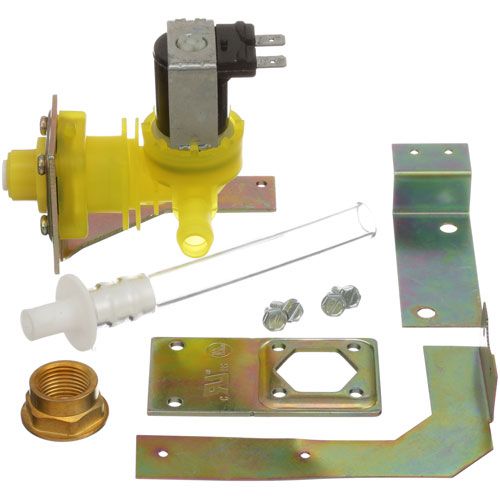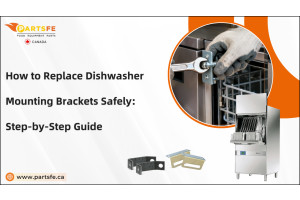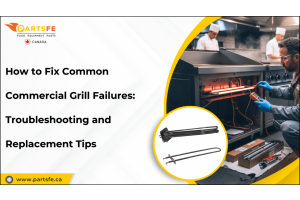Clean or Replace Ice Machine: Here’s Everything You Need To Know
Ice machines are essential appliances in various settings, such as restaurants, hotels, and healthcare facilities, providing a continuous supply of ice for beverages and food service. However, regular maintenance is critical to ensure their optimal performance. Knowing when to replace or clean your ice machine is vital for maintaining hygiene standards, preventing malfunctions, and extending the equipment's lifespan.
Why is it important to clean or replace your ice machine?
It's important to clean or replace your ice machine for several key reasons, including hygiene, quality of ice production, equipment lifespan, and energy efficiency Regular cleaning of an ice machine is vital to prevent the growth of bacteria, mold, and other contaminants. Failure to keep the ice machine parts clean can lead to the production of unsanitary ice, posing health risks to consumers. A clean ice machine ensures that the ice cubes are clear, taste-free, and free from impurities, maintaining the integrity of the beverages and food they serve. Regular cleaning prevents mineral build-up, corrosion, and bacterial growth, reducing the risk of malfunctions and the need for premature replacements. Ice machines that are blocked with dirt or mineral deposits have to work harder to make ice, which increases energy usage. Regular cleaning ensures that your ice machine meets health and safety standards. Cleanliness and hygiene are critical components of meeting food service standards and following local health rules.
Signs that your ice machine needs cleaning
Here are some signs that indicate your ice machine needs cleaning:
-
Reduced ice production: If the ice machine is producing less ice than usual, it may be due for a complete cleaning. Mineral deposits, scale, and debris can collect over time and reduce the machine's efficiency.
-
Cloudy or off-flavored ice: Cloudy or off-flavored ice cubes are a clear sign of potential contamination or impurities in the ice machine. This can be caused by a buildup of dirt and other substances within the machine's components.
-
Unusual odors: Foul or unusual odors emanating from the ice machine are indicative of mold, mildew, or bacterial growth.
-
Visible dirt or scale: If you see visible dirt, scale, or slime inside the ice maker, it's a clear sign that cleaning is overdue. These contaminants can compromise the cleanliness and safety of the ice produced.
-
Water quality issues: If the ice cubes have an unusual taste or appearance, it could be due to poor water quality caused by a dirty ice machine. This may be caused by mineral deposits, mold, or bacterial growth within the machine.
How to clean your ice machine?
Cleaning an ice machine is essential for maintaining its effectiveness and preventing the growth of bacteria and mold that can taint the ice. The process includes both indoor and outdoor cleaning duties.
|
Cleaning the Interior of an Ice Machine |
Cleaning the exterior of an Ice Machine |
|
Before cleaning, ensure the ice machine is turned off and unplugged to prevent accidents. |
Turn off and disconnect the ice machine from power sources to prevent electrical hazards during cleaning. |
|
Remove any ice from the storage bin and allow the machine to drain any remaining water. |
Clean the exterior surfaces of the ice machine using a moist cloth and mild, non-abrasive cleaner, focusing on the side panels, top, and front. Address any visible dirt, smudges, or spills. |
|
Take out relevant interior parts, like the ice storage bin and ice maker, following the manufacturer's instructions. |
Gently clean the control panel with a soft, damp cloth and mild detergent to remove built-up dirt or residue. |
|
Use a mild detergent, warm water, and a sanitizing solution to thoroughly clean and sanitize the ice machine bin |
Use a food-safe sanitizer to sanitize high-touch areas like door handles, buttons, or levers as per the manufacturer's instructions. |
|
Use a manufacturer-approved cleaner to remove scale and deposits from the ice maker and evaporator. |
After cleaning and sanitizing, use a clean, dry cloth to thoroughly dry all exterior surfaces, including crevices or seams, to prevent moisture buildup. |
|
Check water filters for clogs or wear. Replace if necessary and clean filter housing. |
Inspect the exterior for signs of damage, such as dents, scratches, or wear. Address any superficial issues to maintain appearance and integrity. |
How often should you clean your ice machine?
The frequency of cleaning depends on how often the machine is used, the type of water used, and whether you notice any of the signs mentioned above. Here’s a general guideline:
-
Commercial Ice Machines: These should be cleaned and sanitized at least once a month, as they are in constant use and have a higher chance of accumulating bacteria, mold, and mineral deposits.
-
Residential Ice Machines: If your machine is used moderately, cleaning it every 3-6 months is usually sufficient.
-
Heavy Users or Hard Water Areas: If you use your ice machine frequently or live in an area with hard water, you may need to clean it more often (every 1-2 months).
Signs that your ice machine needs replacing
If your ice machine is experiencing frequent breakdowns despite regular maintenance and repairs, it may be a sign that the equipment is reaching the end of its lifespan and needs to be replaced.
-
Outdated technology: Technological advancements in ice machine design and efficiency may render older models obsolete. If your ice machine lacks modern features or is consuming more energy than newer models, it might be time for an upgrade.
-
Reduced ice production: A significant drop in ice production, even after thorough cleaning and maintenance, could indicate that the ice machine's components are worn out and no longer functioning optimally. If your ice machine is generating less ice than usual, this could be due to a variety of circumstances. PartsFe Canada is the best source to find Scotsman or Hoshizaki ice machine parts. We provide a comprehensive collection of Scotsman, Hoshizaki ice machine parts, such as ice machine valves, screws, and motors, at low rates.
-
Excessive wear and tear: Visible signs of extensive wear and corrosion on critical components such as the freezing unit, condenser, or evaporator may indicate that the ice machine is no longer capable of operating at peak performance.
-
Persistent hygiene issues: If your ice machine continuously struggles with hygiene-related problems, such as mold, bacterial growth, or persistent odor issues, despite regular cleaning, it may be a sign that the internal components are compromised and need to be replaced.
How to replace your ice machine?
Evaluate the condition of your current ice machine, taking into account factors such as age, efficiency, and the extent of wear and tear.
-
Research and purchase: Research modern ice machine models and select one that meets the needs of your establishment in terms of capacity, energy efficiency, and other relevant features. Purchase the new ice machine from a reputable supplier or distributor.
-
Professional consultation: Consider seeking advice from a professional service technician or a representative from the ice machine manufacturer to ensure that the new machine meets the specific requirements of your establishment.
-
Professional installation: Engage a professional service technician to install the new ice machine. Professional installation ensures that the machine is set up correctly, integrated with existing water and power connections, and complies with relevant building and safety codes.
-
Testing and calibration: After installation, the technician will conduct testing and calibration to confirm that the new ice machine is operating properly and efficiently.
-
Proper disposal: Arrange for the proper disposal or recycling of the old ice machine according to local regulations and environmental standards. Collaboration with a certified service or waste management company may be necessary for safe and responsible disposal.
-
Maintenance schedule: Establish a maintenance schedule for the new ice machine, including regular cleaning, filter replacement, and professional servicing as recommended by the manufacturer. Adhering to a maintenance schedule will help ensure the longevity and efficiency of the new equipment.
Choosing the right ice machine for replacement
If you’ve decided it’s time to replace your ice machine, selecting the right one is crucial. Here are a few factors to consider:
-
Size and Capacity: Determine how much ice you need daily and choose a machine that can handle your requirements. Commercial machines usually produce ice in large quantities, while residential machines are more compact and suited for smaller needs.
-
Type of Ice: There are different types of ice—cubes, flakes, nuggets, and more. Choose a machine based on the type of ice you prefer or need for your business.
-
Energy Efficiency: Look for energy-efficient models that can help reduce your electricity bills and carbon footprint.
-
Maintenance and Warranty: Choose a brand that offers reliable customer service and a solid warranty. A machine with a long warranty can give you peace of mind.
Regular maintenance and timely replacement or cleaning of your ice machine are crucial for maintaining its efficiency and ensuring the production of clean, safe ice. By staying vigilant for signs such as reduced ice production, foul odors or tastes, visible mold or slime, and increased energy consumption, you can address issues promptly and prevent potential health hazards. Remember to follow manufacturer guidelines for cleaning and maintenance, and consider scheduling regular professional servicing to keep your ice machine in optimal condition for longer. With proper care, your ice machine will continue to serve its purpose reliably, providing ice that meets hygiene standards and satisfies your needs.
FAQs
When should I clean the ice machine?
It is recommended that you clean your ice maker regularly, usually every 3-6 months, depending on usage and manufacturer recommendations. However, if you discover any signs of contamination or low ice quality, clean it right away.
How can I know if my ice machine requires cleaning?
Signs that your ice machine needs to be cleaned include decreased ice production, foul aromas or tastes in the ice, visible mildew or slime, ice discoloration, or the presence of silt or particles in the ice.
What are the consequences of not cleaning my ice machine?
Failure to clean your ice maker can result in the growth of hazardous bacteria, mildew, and slime, contaminating the ice and posing health hazards to users. Additionally, it can reduce the machine's efficiency and lifespan.
Can I repair individual pieces rather than cleaning the entire ice machine?
Yes, in some situations, individual components of the ice machine, such as the water filter, Ice Maker Water Valve, evaporator, or ice bin, may require replacement rather than cleaning.
How can I keep my ice maker clean in between cleanings?
To keep your ice machine in good condition between cleanings, inspect it for signs of contamination, disinfect high-touch surfaces, change water filters as needed, and ensure optimum ventilation and water quality.








